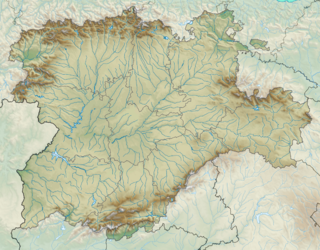 W
WAroeira 3 is a 400,000 year old Homo heidelbergensis hominid skull which was discovered in the Aroeira cave, Portugal. It is the earliest human trace in Portugal. H. heidelbergensis existed at the transition between Homo erectus and early Neanderthals and used both stone tools and fire. The skull was damaged during the 2014 excavation but was restored in the following two years. In 2017 the description of the skull was published in PNAS. It is on display in the National Archaeology Museum (Lisbon).
 W
WThe Cave of Aroeira is an archaeological and paleoanthropological site in the Portuguese Estremadura Limestone Massif. The cave is located in the village of Almonda, in the civil parish of Zibreira, in the municipality of Torres Novas in the district of Santarém. The cave contained stones from the Paleolithic Acheulean culture, and the skull of Homo heidelbergensis, circa 400,000 years old. The discovery of Aroeira 3 was announced in spring 2017 - the earliest human trace in Portugal.
 W
WKabwe 1 is a Middle Paleolithic fossil assigned by Arthur Smith Woodward in 1921 as the type specimen for Homo rhodesiensis, now mostly considered a synonym of Homo heidelbergensis.
 W
WThe following tables give an overview of notable finds of hominin fossils and remains relating to human evolution, beginning with the formation of the tribe Hominini in the late Miocene, roughly 7 to 8 million years ago.
 W
WThe Mauer 1 mandible is the oldest-known specimen of the genus Homo in Germany. It was found in 1907 in a sand quarry in the community Mauer, around 10 km (6.2 mi) south-east of Heidelberg. The Mauer 1 mandible is the type specimen of the species Homo heidelbergensis. Some European researchers have classified the find as Homo erectus heidelbergensis, regarding it as a subspecies of Homo erectus. In 2010 the mandible's age was for the first time exactly determined to be 609,000 ± 40,000 years. Previously, specialist literature had referred to an age of either 600,000 or 500,000 years on the basis of less accurate dating methods.
 W
WMiguelón is the popular nickname for a human skull, classified as either late Homo heidelbergensis or as early Homo neanderthalensis. It has been estimated to date to 430,000 years ago. It is one of more than 5,500 fossils belonging to early human populations which have been found in the Sima de los Huesos site in the Sierra de Atapuerca in northern Spain.
 W
WSaldanha man also known as Saldanha cranium or Elandsfontein cranium are fossilized remains of an archaic human. It is one of the key specimens for Homo heidelbergensis. It has not been dated directly, and is estimated to be roughly 0.5 million years old. The remains, which included a fragment of lower jaw, were found on an exposed surface between shifting sand dunes on the farm Elandsfontein, which is located near Hopefield, South Africa.
 W
WSamu is the nickname given to a fragmentary human occipital bone found in Vértesszőlős, Central Transdanubia, Hungary. The discovery was made on 21 August 1965 during a dig led by László Vértes, and the fossil was named Sámuel, 21 August being the name day of biblical judge Samuel in Hungarian tradition. It has since become widely known as Samu, a Hungarian short form of the name.
 W
WThe archaeological site of Atapuerca is located in the province of Burgos in the north of Spain and is notable for its evidence of early human occupation. It was designated a World Heritage Site in 2000.
 W
WThe Steinheim skull is a fossilized skull of a Homo neanderthalensis or Homo heidelbergensis found on 24 July 1933 near Steinheim an der Murr, Germany. It is estimated to be between 250,000 and 350,000 years old. The skull is slightly flattened and has a cranial capacity between 950 and 1280 cc. Sometimes referred to as Homo steinheimensis in older literature, the original fossil is housed in the State Museum of Natural History in Stuttgart, Germany. Some believe that the Steinheim skull may have belonged to an adult female due to its gracile nature.
 W
WSwanscombe Skull Site or Swanscombe Heritage Park is a 3.9 hectares geological Site of Special Scientific Interest in Swanscombe in north-west Kent, England. It contains two Geological Conservation Review sites and a National Nature Reserve. The park lies in a former gravel quarry, Barnfield Pit.